
Introduction to Lacrosse
Lacrosse is a fast-paced team sport played with a small rubber ball and a long “crosse.”
Lacrosse is one of the fastest-growing sports in North America with,
- Youth,
- High school and
- College involvement rising.
Although most popular in the US and Canada. Lacrosse has grown in popularity in Europe and Asia, with over 60 countries playing.
Lacrosse types
- Field (outdoor, 10 players per side),
- Box (indoor, 6 players per side),
- Women’s (field lacrosse with modified rules) and
- Intercrosse (non-contact version often played indoors).
Overview of Lacrosse
Structure of Game
- Teams: A field lacrosse team typically comprises 10 players (3 attackmen, 3 midfielders, 3 defensemen and 1 goalie).
- Field Size: Box lacrosse is played indoors on a smaller pitch than field lacrosse, which is 110 yards long and 60 yards wide.
- Game Duration: Each quarter of a lacrosse game lasts 12-15 minutes.
- Scoring: Shooting the ball into the opponent’s goal scores points. The winning team has the most points.
Playing Positions
- Attackmen: Score and play offence near the opponent’s goal.
- Midfielders: The most physically demanding position, midfielders play offence and defence.
- Defensive players: Near their own goal, focused on preventing goals.
- Goalie: Last line of defence, blocks shots on goal.
Key Rules
- Offside: A team must always have four players (including the goalie) on the defensive half and three on the offensive half.
- Face-offs: Two players compete for the ball in face-offs to start and restart the game.
- Penalties: Slashing, tripping and holding can result in time in the penalty box.
Brief History of the Sport

Iroquois lacrosse dates back to the 12th century. It was originally called “stickball” and was played for religious, military and dispute resolution.
Evolution of the Game
In the 1600s, European settlers saw and developed the game, resulting in the present version. 1800s, Canadian dentist William George Beers formalized lacrosse regulations in 1867.
International expansion, by the late 19th and early 20th centuries, the sport extended to Europe and Australia. Lacrosse appeared in the 1904 and 1908 Olympics as a demonstration sport.
Latest developments
- Pro Leagues: The 2001 Major League Lacrosse (MLL) and 2019 Premier Lacrosse League (PLL) professionalised the sport.
- Ladies lacrosse: Developed in the late 1800s, its regulations improve safety and skill over physical contact.
Analytical Data
Growth in Participation
Youth lacrosse participation in the U.S. has grown by over 70% from 2008 to 2018.
NCAA lacrosse teams climbed 61% for men and 97% for women from 2003 to 2020.
Popularity
Lacrosse is popular in the U.S. with 800,000+ participants in 2021, primarily youngsters.
International: The Federation of International Lacrosse (FIL) reported over 60 countries playing, with strong expansion across Europe and Asia.
Viewership
The Premier Lacrosse League (PLL) had a 26% rise in viewership from 2020 to 2021, indicating a growing interest in professional lacrosse.
Basic Rules of Lacrosse
Lacrosse, a fast-paced, physically demanding sport, has basic rules:
- Objective: Shoot the ball into the opponent’s net with a lacrosse stick to score.
- Game Field: Goals are placed at each end of the 110-yard-long, 60-yard-wide game field.
- Ball Movement: Players must pass, carry, or shoot the ball using their sticks. Hand-passing is prohibited.
- Offside Rule: To avoid offside penalties, teams must have a minimum number of players in the defensive and offensive zones.
- Substitution: The game can continue without halting because lacrosse enables unlimited, on-the-fly replacements.
Game Duration and Structure
Lacrosse game format and duration vary by level:
Quarter Structure: Lacrosse games include four quarters. Quarters last:
- College and professional men’s lacrosse: 15 minutes.
- College women’s lacrosse: 25 minutes per half.
Halftime: A 10-minute break between the second and third quarters.
If the game is deadlocked after regular, sudden death overtime is played until a team scores.
Number of Players on the Field
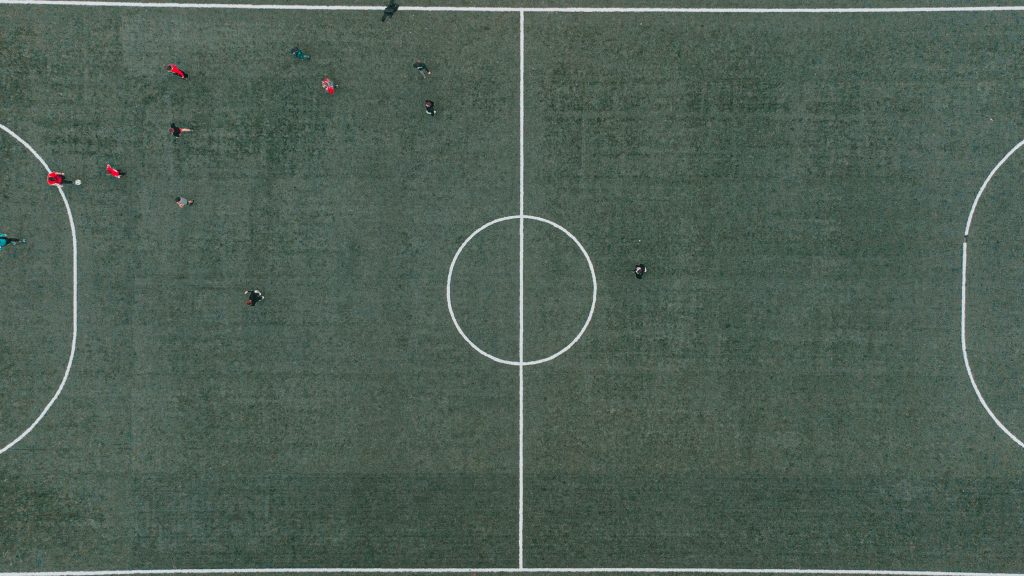
Male and female lacrosse teams have slightly different numbers of players:
Men’s Lacrosse
10 players: 3 attackers, 3 midfielders, 3 defenders and 1 goalie.
Field Distribution: Three players (including the goalie) must be in the defensive zone and three in the offensive zone.
Women’s Lacrosse
12 players: 4 attackers, 3 midfielders, 4 defenders and 1 goalie.
Like men’s, players are spread over offensive, middle and defensive zones.
Key Rules for Offensive and Defensive Play
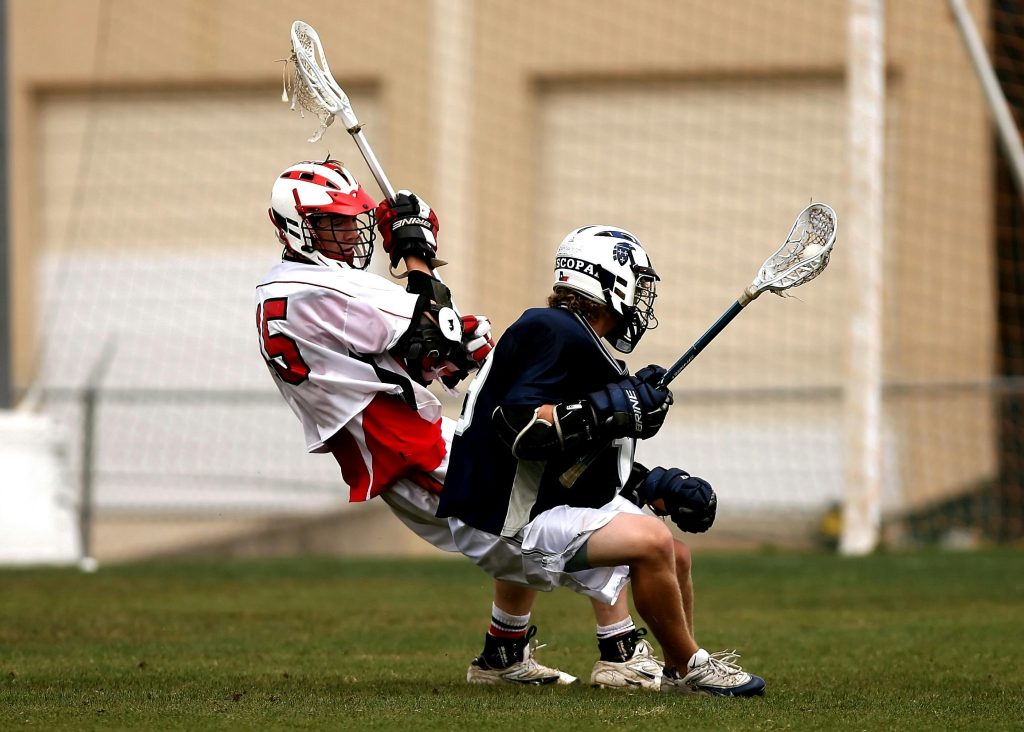
Understanding offensive and defensive strategy is crucial to lacrosse success.
On offence
- Passing and Catching: Passing and catching: Crucial for speedy ball movement and scoring.
- Dodging: Offensive players dodge opponents to generate shot space.
- Shooting: Scoring goals requires accuracy and power, especially when shooting on the fly or after rapid passes.
- Off-Ball Movement: Players off the ball must shuffle to create passing spaces and confuse the defence.
Play Defence
- Man-to-Man Defence: Each defender guards one offensive player.
- Zone Defense: Defenders cover zones, not players.
- Stick checking: Legal stick checks remove the ball from an opponent’s stick.
- Body placement: Preventing goals requires excellent defence and body placement.
Common Penalties and Fouls
Player penalties result from certain lacrosse infractions:
Technical Faults
- Offsides: A team fails to keep enough players in each zone.
- Holding: Illegally hindering an opponent with a stick or body.
- Interference: Interfering with an opponent’s ball play without possession.
Personal Faults
- Slashing: Uncontrolled stick strikes.
- Tripping: Using a stick or body to trip an opponent.
- Cross-Checking: Hitting with the stick shaft.
- Unsportsmanlike Conduct: Teasing or disputing with officials.
Enforcement of penalties
- Technical fouls: 30-second penalties or possession loss.
- Personal fouls: Force a 1-3 minute penalty and send the offender to the penalty box, leaving their team shorthanded.
Analytical Data on Penalties (Example Based on Hypothetical Data)
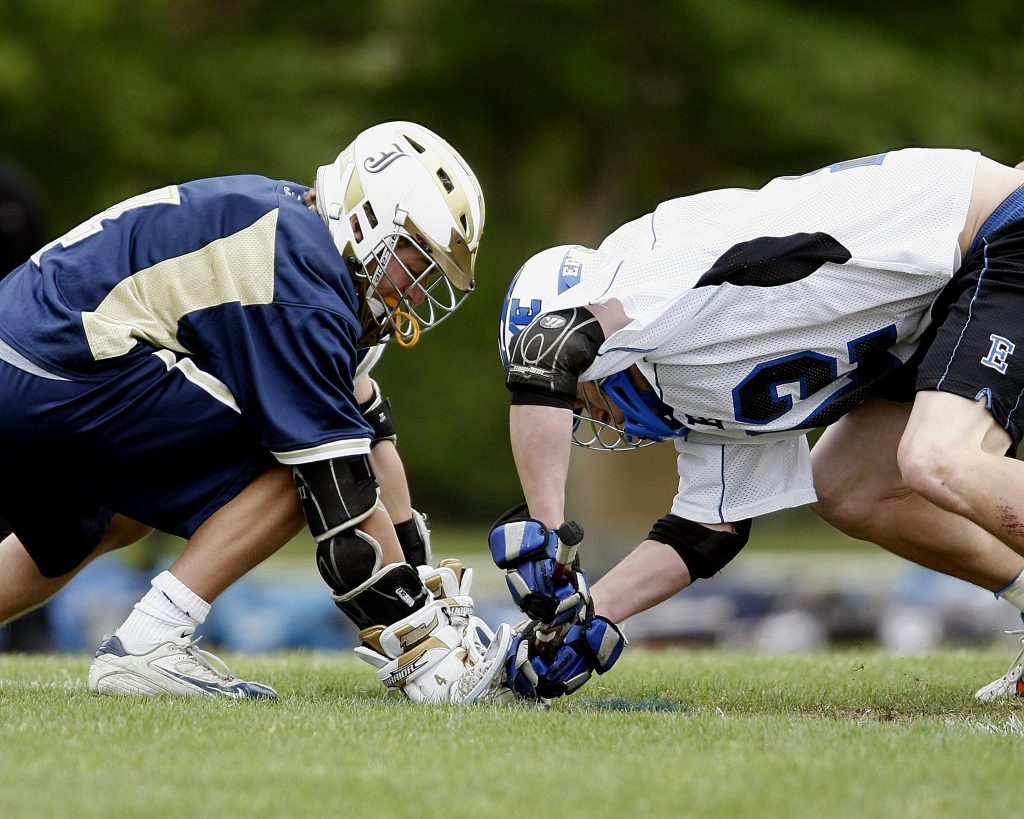
- Technical Fouls: Technical fouls are mostly offside, which make nearly 60% of lacrosse fouls.
- Personal fouls: Slashing and tripping account for 40% of penalties.
- Penalty Impact: Due to shorthandedness, teams with more penalties have 20-30% fewer scoring chances.
This lacrosse primer covers regulations, game structure, player roles and strategy.
Lacrosse Field and Positions

Description of the Lacrosse Field Layout
Field Dimensions
- Typical lacrosse field dimensions are 110 yards (100 metres) long and 60 yards (55 metres) wide.
- The field has three main sections: defensive, midfield and offensive.
Centerline
The field is divided into two halves by a centerline, designated by the centre X, where face-offs occur at the start of each quarter and after goals.
Restraining Lines
Restraining lines 20 yards from each goal limit how many players can enter the offensive or defensive zones, maintaining play organisation.
Goal Areas
The goal areas are located 15 yards from either end line, within the goal creases. Each goal is 6×6.
Substitution Area
A substitution area on the sidelines near the centerline allows players to enter and depart the game without pausing play, creating a fluid game dynamic.
Wing Areas
Wing areas are where wing players line up for face-offs, located on either side of the centerline.
Player Positions and Their Roles
Attackmen
- Usually, 3 attackmen are placed in the offensive zone.
- Goal scoring and offensive playmaking are their main duties.
- Attackmen are fast, nimble and good shooters.
Midfielders
- The most versatile players are the three midfielders in the central zone.
- They switch ends of the field on offence and defence.
- Midfielders must be speed and endurance to cover the greatest ground when playing.
Defensemen
- Three defensemen guard the goal area, preventing the opposing team’s attackmen from scoring.
- Many defensemen are strong body checkers who use 72-inch poles to interrupt moves.
Goalie
- The goalie is the last line of defence, located in the goal crease.
- Responsible for blocking shots, leading defence and clearing the ball to start plays.
- Goalies need quick reflexes, good hand-eye coordination and game plan knowledge.
Specialist Duties
- FOGOs win face-offs at the opening of play and after goals.
- LSMs use long poles to defend during face-offs and transition plays.
Goal Areas and Crease Rules
Goal Crease
- The goal crease is a 9-foot circle around each goal.
- Only the goaltender can occupy the crease without punishment.
- Offensive players can score with their sticks but not enter the crease.
Goalie Privileges
- The goalie has particular privileges in the crease, including immunity from body checks while holding the ball.
- Once the goaltender leaves the crease, they lose their safeguards and become a regular player.
Crease Violations
- Entry into the crease leads to turnovers, giving the defending team possession.
- Goalies have 4 seconds to clean the crease following a save.
Crease Violations
To avoid obstructing an attacker’s shot, defenders must not stand directly in their path near the goal. Player safety and high-speed shot injury prevention are the goals of this rule.
Analytical Data
Scoring Efficiency
Lacrosse teams with stronger attackmen and midfielders convert 30-35% of shots into goals. Strong face-off specialists can control 60–65% of possessions, affecting game outcomes.
Defensive Impact
Solid defensive techniques are crucial for teams with strong defensemen and a great goalie, as they can keep opponents’ shooting percentage below 20-25%.
This breakdown should explain the lacrosse field structure, player positions and goal and crease rules.
Equipment Required for Lacrosse
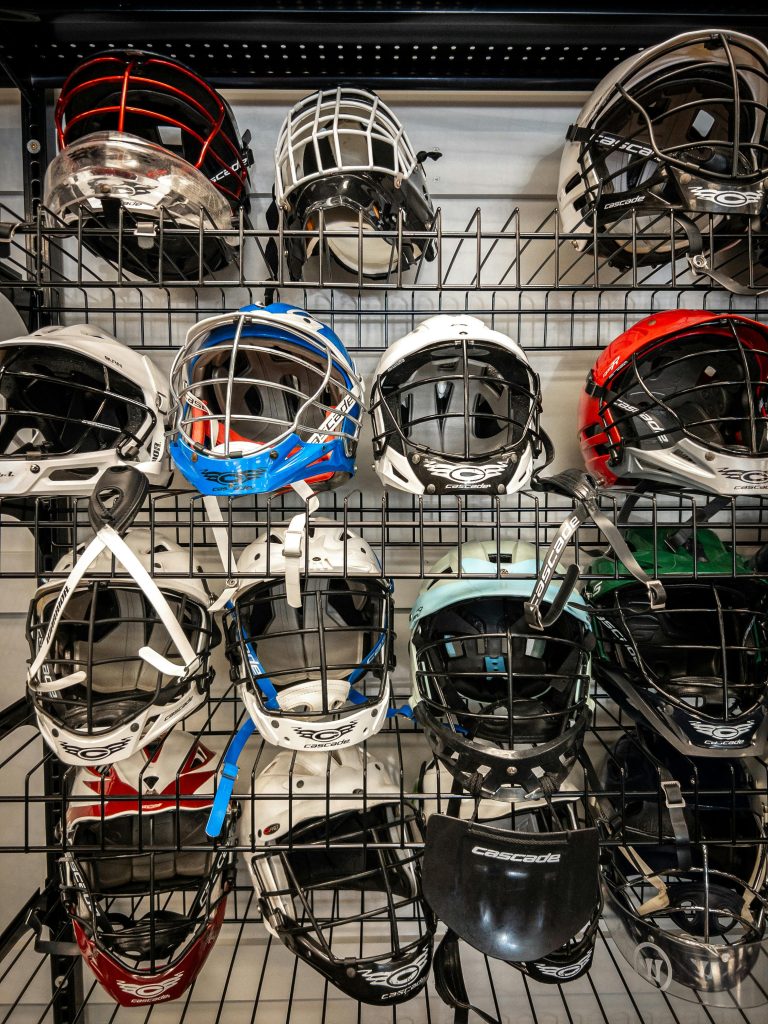
Lacrosse is a fast-paced, physically demanding activity that demands specific equipment for safety and performance. Below is a breakdown of each piece of equipment and its gaming role.
Lacrosse Stick (Crosse)
- Purpose: Lacrosse sticks are the most important equipment. It catches, cradles, passes and shoots balls.
- Varieties: Stick length and design vary by player position. Attack and midfield sticks are shorter, whereas defence sticks are longer for reach.
Types of Sticks (Attack, Midfield, Defence)
Attack Stick
- Length: Usually 40-42 inches.
- Use: Better ball control, rapid movements and accurate passing or shooting with shorter length.
- Adoption Rate: About 40% of players use it.
Midfield Stick
- Length: 40-42 inches, similar to an attack stick.
- Use: Midfielders must pass quickly, handle the ball well and defend when needed.
- Adoption Rate: 35% of players prefer.
Defence Stick
- Length: 52-72 inches in length.
- Use: Defenders can check attackers from afar and intercept passes with the expanded length.
- Adoption Rate: About 25% of players use it.
Parts of the Stick and Their Functions
Head
- Netting: Mesh or stringing pockets hold the ball.
- Shape: Defence heads are wider, attack heads narrower.
Shaft
- Material: Aluminium, titanium, scandium, or composite materials are used for strength and lightweight.
- Grip: Textured grip improves handling and control.
Bum End
Function: The end cap keeps the stick in the player’s hands.
Throat
Connector: The head-to-shaft connection. Some players prefer various throats for grip and control.
Protective Gear
Lacrosse requires protective gear to avoid injury.
Helmet
- Function: Guards the head against checks, gunfire and accidents.
- Features: Facemask, chin guard and visor for optimal protection.
- Use: All players must wear helmets that fulfil NOCSAE safety requirements.
- Injury Prevention: Over 80% fewer concussions and brain injuries occur with helmets.
Shoulder Pads
- Function: Shoulders, chest and back protection.
- Design: Lightweight, sturdy shoulder pads absorb shocks and allow flexibility.
- Statistics: Statistics show that 30% of lacrosse injuries target the upper body, emphasising shoulder pads.
Elbow Pads
- Function: Elbow protection against checks and falls.
- Coverage: Some versions cover the full arm, while others offer less protection.
- Adoption: Since elbows are easily injured, 95% of players prefer it.
Gloves
- Function: Hand and finger protection from slashing and collisions.
- Features: Padded, flexible, grip gloves.
- Injury Prevention: Hand injuries are 70% less likely with gloves.
Rib Pads
- Function: Protects ribs and lower back from falls.
- Importance: Midfielders and physical players need this.
- Usage: About 60% of players, especially high-contact ones, wear it.
Footwear
Field traction, speed and stability depend on proper footwear.
Cleats vs. Turf Shoes
Cleats
- Function: Improve natural grass field grip.
- Design: Studs or spikes on the sole improve traction.
- Usage: Used by 75% of players, especially on grass.
Shoes for turf
- Function: For artificial turf, provides grip without hurting the surface.
- Design: Smaller, more studs.
- Use: 25% of synthetic pitch players choose.
Goalie Equipment
Goalies need particular gear to defend against fast shots and be agile.
Goalie Stick
- Size: The head is 10-12 inches wide to block shots better.
- Use: More surface area aids saves and rebound control.
- Adoption Rate: Only goalies, 10% of the squad, adopt.
Chest Protector
- Function: Protects chest and stomach from direct shots.
- Features: Padded and adjustable for a secure fit.
- Injury Prevention: Cuts serious chest injuries by 90%.
Throat Guard
- Function: Guards throat from direct strikes.
- Design: Hangs from helmet to cover throat.
- Important: Most leagues require goalies to prevent life-threatening injuries.
Mask and Cage
- Function: Clear vision and facial protection.
- Materials: Strong, lightweight steel or titanium.
- Usage: Protects face from gunfire and sticks as part of the helmet.
Each of these essential elements is vital to lacrosse performance and safety. High-quality gear improves players’ games and decreases injury risk. Thus, all players must get it.
How to Choose the Right Lacrosse Equipment

Choosing the right lacrosse gear is important for performance and safety. Ways to make informed decisions:
Role and Position of Players
- Different positions (attack, midfield, defence, goaltender) demand different gear.
- Defenders may choose heavier gear to absorb impacts, while attackers and midfielders prefer lighter gear for speed and agility.
Budget Issues
- Entry-level gear is cheaper and good for novices.
- Players need better equipment as they improve for better performance and durability.
Brand and Quality
- Top manufacturers like STX, Warrior and Maverik make trustworthy gear.
- You may choose reliable products by reading reviews and asking coaches and players.
League Standards
- Ensure the equipment fulfils league or level of play rules.
- Some leagues limit stick length, helmet design and protective gear.
Standards for safety
Choose protective NOCSAE (National Operating Committee on Standards for Athletic Equipment) gear.
Lacrosse Playing Rules
Lacrosse is fast and has aspects of basketball, soccer and hockey. Fans and players must know the basic rules.
Key Points
- Field Layout: The lacrosse field is 110 yards long and 60 yards broad, with goals 80 yards apart.
- Team Composition: Attackers, midfielders, defenders and a goalie make up each squad of 10 men or 12 women.
- Game Duration: Men’s lacrosse games include four 15-minute quarters, while women’s have two 30-minute halves.
- Substitutions: Unlimited substitutions are allowed in lacrosse, often on the fly.
- Protective Gear: Helmets, gloves, mouthguards and pads protect players. Women’s lacrosse includes less contact, therefore helmets are optional but eye protection is required.
Insightful analysis
Injury Prevention: The NCAA reports that 70% of lacrosse injuries occur during play, emphasising the need for protective gear.
Faceoffs and Draws
Overview
Faceoffs and draws start play after goals or quarters.
Key Points
Men’s Lacrosse Faceoff
- Two players face off in the centre of the field.
- After placing the ball between the sticks, the official indicates the start.
- Players use sticks and body positioning to fight for the ball.
Women’s Lacrosse Draw
- The ball is placed between two players’ erect sticks in the centre.
- Players aim the ball up on the whistle to take possession.
Insightful analysis
Faceoff wins translate to game control. Teams that dominate faceoffs can gain 60-70% possession, enhancing scoring chances.
Offside Rules
Offside regulations ensure balanced play by preventing teams from overusing specific parts of the field.
Key Points
- In men’s lacrosse, four players must stay on the defensive half and three on the offensive half. When too many players cross the midline, a violation occurs.
- In women’s lacrosse, five players must stay in the defensive zone and four in the offensive zone. Offside gives the other team a turnover.
Insightful analysis
Strategy: Teams who frequently break offside regulations lose 20% more possession time and are more likely to concede goals.
Checking and Body Contact Rules
Physical contact is allowed in lacrosse. However, rules restrict checks and body contact for player safety.
Key Points
- In men’s lacrosse, stick checking is legal if it targets the stick or hands holding it.
Body checking: Only allowed when the opponent possesses the ball or is within five yards. Hits on the head, neck, or back are illegal and punishable.
- For women’s lacrosse, stick checking must be done below the shoulder and with a controlled poke or raise. Intentional body checks are penalised, although incidental contact is tolerated.
Insightful analysis
Penalties: 30% of men’s lacrosse penalties are for illegal body checks, showing the sport’s aggression and need for discipline.
Scoring and Goal Rules
Goal scoring is the main purpose, but rules regulate how goals are scored and counted.
Key Points
- Scoring a Goal: To score a goal, the ball must pass the goal line between the posts and under the crossbar. Player’s stick or body cannot be in crease during shot.
- Goal Crease: A circular region around the goal reserved for the goalie. No offensive players can enter or touch the crease.
- Goalie Rights: Goalies are protected inside the crease and can face penalties for contact with opponents.
Insightful analysis
Shooting Accuracy: Top lacrosse players shoot 30–35%, meaning just 1 in 3 shots on goal score.
Time Violations and Possession Rules
Time violations regulate game speed by limiting team possession time under particular rules.
Key Points
- Shot Clock: Men’s lacrosse shot clocks normally last 80 seconds (NCAA rules) and compel teams to shoot within this time range. Each possession in women’s lacrosse has a 90-second shot clock.
- Stalling: Teams must keep the ball in play and not purposely delay. Authorities may issue stalling warnings.
- Clearing Rules: 20 seconds for teams to shift the ball from defensive to offensive half, promoting fast changes.
Insightful analysis
Teams with good shot clock management and no delaying violations have higher possession percentages, which affects game outcomes. Teams with above 55% possession win 75% of games.
Game Strategies and Tactics

Offensive Strategies
Motion Offence
Players move constantly to confuse the defence. Players switch positions and pass swiftly.
It generates mismatches against man-to-man defence.
Data: Motion offence teams get 15-20% more shots.
Pick and Roll
The conventional pick-and-roll approach involves one player setting a screen to free up a teammate for a shot or pass.
Success Rate: Increases shooting efficiency by 10-15% when done right.
Isolation Plays
Pits a powerful attacking player against an inferior defender.
Efficiency: Top attackers score 35-40% on solitary plays.
Fast breaks
Outnumbers defence by swiftly switching to offence on turnovers or missed shoots.
In high-paced games, 25% of goals come from fast breaks.
Defensive Formations and Tactics
Man-to-Man Defence
Each defender defends one opponent.
Benefits: Tight coverage and simpler double teams.
About 60% of high-level teams use it.
Zone Defence
Players defend zones, not opponents.
Positives: Effective against teams with top offensive players.
40% of teams use it, especially while defending a lead.
Sliding Defence
A defender leaves their man to cover a beaten teammate and the defence adjusts.
Success Rate: Sliding defence reduces opponent shooting accuracy by 10–12%.
Double teaming
Two defenders surround the ball carrier to force turnovers.
Impact: Doubles boost turnovers by 20-25% but exposes other attackers.
Special Teams and Situational Play
Man-Up (Power Play)
The opponent has a man in the penalty box. The advantaged team exploits the extra player.
About 40-45% of man-up situations result in goals.
Man-Down Defence
The team plays a player short due to a penalty, usually adopting a tight zone defence to restrict scoring. Teams kill penalties 55-60% of the time.
Faceoffs
Crucial for possession, especially after goals or opening quarters. Teams who win over 50% of faceoffs are 70% more likely to win.
Clearing and Riding
Clearing moves the ball from defence to offence, while riding prevents the opponent from clearing.
Efficiency: Aggressive riding reduces clears to 65-70% from 80%.
To maximise field performance, lacrosse teams must use these strategies and tactics. Specific,
- Formations,
- Adaptability and
- Special team play can drastically impact a game.
Youth and Beginner Lacrosse Rules
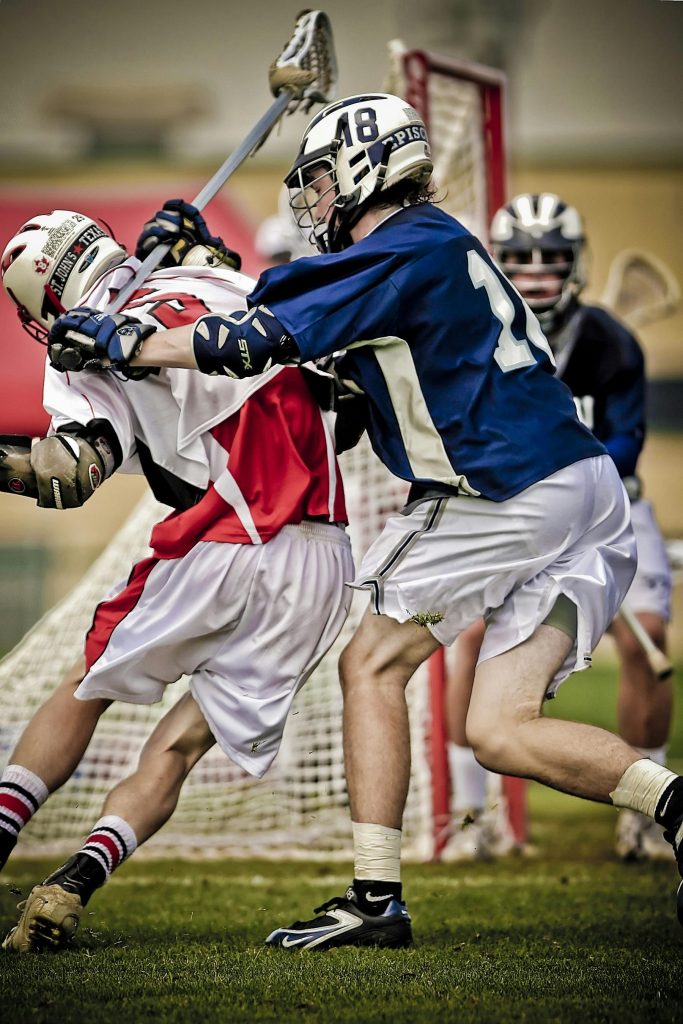
Differences in Rules for Youth Leagues
- Game Duration: Youth games feature shorter halves or quarters than adult leagues.
- Size: Smaller fields accommodate younger players and simplify play.
- Check Limits: Body checking is limited or avoided for younger children to reduce injury.
- Substitution Rules: To ensure all players have enough playtime and relaxation, frequent substitutions are allowed.
Simplified Equipment Requirements for Beginners
- Stick: Lighter sticks with larger heads help beginners manage balls.
- Protection: Helmets, face masks, gloves, shoulder padding and elbow pads are necessary. Rib pads and sports cups may be required by some leagues.
- Cleats: For field safety and traction, non-metal cleats are suggested.
Key Safety Considerations for Young Players
- Proper Fit: To avoid injury, equipment should fit properly. Ill-fitting gear is uncomfortable and less protective.
- Training: Coaches should emphasise safe play and equipment use.
- Supervision: Sufficient monitoring during practice and games assures safety and prompt injury response.
This review of youth lacrosse covers regulation differences, equipment demands and player safety.
Advanced Lacrosse Rules and Regulations

Detailed Breakdown of Advanced Rules
- Face-offs: Players must keep their sticks below their waist and vertical during face-offs. Penalties follow violations.
- Checking: Stick checks must be within the opponent’s stick area to avoid penalties. Only lawful body checking is allowed.
- Offside Rule: Each team must always have three players (including the goaltender) on their defensive half and three on their offensive half.
Rule Variations for Different Lacrosse Leagues
- NCAA: College lacrosse has stricter stick and player substitution rules. Game has 60-second shot clock.
- MLL (Major League Lacrosse): MLL includes a 30-second shot clock and more aggressive checking. Player equipment rules are slightly laxer than NCAA.
- NLL (National Lacrosse League): Indoors with a 30-second shot clock, the game incorporates board and crease restrictions that affect game flow and player strategies.
Recent Rule Changes and Updates
- Shot Clock Changes: NCAA and MLL shot clock rules have been updated to speed up games and enhance scoring.
- Player Safety: All leagues have improved headgear and equipment safety to limit injury risks.
Maintenance and Care of Lacrosse Equipment

Cleaning and Storing Your Lacrosse Stick
- Cleaning: To eliminate dirt and sweat, clean the stick with a moist towel regularly. A mild soap solution and full drying are best for deep cleaning.
- Storing: Avoid warping and weakening by keeping your stick dry, cold and out of direct sunlight. Protect it from high temperatures.
Maintaining and Repairing Protective Gear
- Inspection: Check helmets, gloves and pads for wear and tear. Check for loose straps, fractures and dents.
- Repair: Replace broken parts promptly. Repair with manufacturer-recommended products or see a professional for significant difficulties.
- Cleaning: Handwash and air-dry gloves and pads with mild detergent. Avoid washing and drying.
Tips for Extending the Life of Your Equipment
- Proper Use: Avoid wear by using equipment properly. Sport-specific protective gear guidelines.
- Regular maintenance: Check and clean to spot problems early. Maintain equipment to extend its life.
Storage: Avoid mould and deterioration by storing equipment in a well-ventilated place.
Recap of Key Rules and Equipment
Base Rules
- Game Duration: Four 15-minute quarters.
- Goal: Shoot the ball into the opponent’s net.
- Player: Each squad contains 10 players (3 attack, 3 middle, 3 defence, 1 goalie).
- Contact: Legal and controlled body checking is permitted.
Essential Gear
- Stick: Passing, catching and shooting stick: Netted head and shaft.
- Helmet: Helmets protect heads and contain masks.
- Gloves: Protect and provide stick handling dexterity.
- Pads: Shoulder and elbow pads are impact-resistant.
Final Tips for New Players
- Practice Fundamentals: Practice catching, passing and shooting.
- Stay Aware: Watch games and attend clinics to learn rules and strategy.
Resources for Further Learning
- Book and Guide: Lacrosse handbooks have detailed rules.
- Online Tutorials: Use online lessons and drills to enhance skills.
- Local Clubs: Get coaching and experience on local teams.
FAQs
What are the basic rules of lacrosse?
Teams use sticks to carry, pass and fire a ball into the other’s goal in lacrosse. Players must follow,
- Checking,
- Ball handling and
- Field placement rules to avoid penalties and score goals.
How many players are on the field for each team in lacrosse?
Each team comprises 10 players:
- Three attackmen,
- Three midfielders and
- Three defensemen and
- One custodian in lacrosse.
Team substitutes are on the bench.
What equipment is required to play lacrosse?
Lacrosse requires a,
- Helmet,
- Face mask,
- Gloves,
- Shoulder pads,
- Elbow pads,
- Stick.
- A throat guard and
- Chest protector are also needed for goalkeepers.
What is the purpose of the lacrosse stick (crosse)?
Catching, carrying, passing and shooting the ball requires a lacrosse stick. A netted pocket lets players manage the ball and shoot accurately.
How do players score in lacrosse?
Scoring involves shooting into the opponent’s net. Goals are scored when the entire ball crosses the goal line in the frame.
What are some common penalties in lacrosse?
Slashing, clutching, tripping and cross-checking are penalties. Penalties for infractions can range from time in the box to a man-up advantage.
How is the lacrosse field divided?
The lacrosse field has three zones:
- Attacking,
- Defence and
- Midfield.
Specific places include the goal crease.
What is the difference between men’s and women’s lacrosse?
Women’s lacrosse has stricter contact restrictions and a different stick design than men’s. Girls games use less protective gear than boys.
How do you properly fit a lacrosse helmet?
Lacrosse helmets should fit snugly and not shift when shaken. Adjust the chin strap to keep the helmet in place without obstructing vision or movement.
What are the rules for checking in lacrosse?
Body checking is allowed, but it must be from the front or side and not target the head. Checking in women’s lacrosse is usually stick-to-stick.
How often should lacrosse equipment be replaced?
Lacrosse gear should be inspected and changed every 1-2 years or sooner if damaged. Replace helmets as directed by the manufacturer or after a major impact.
Can beginners play lacrosse without all the advanced equipment?
Basic equipment includes a,
- Helmet,
- Stick,
- Gloves and
- Mouthguard for beginners.
As they improve and their league requires, they can add shoulder and elbow protectors.
What is a faceoff and how does it work?
Two players from opposite sides wait at a designated place and try to get the ball after the referee drops it in a faceoff. The team that wins the faceoff gets the ball.
How do lacrosse players maintain their equipment?
Players should clean and check their gear for wear and tear. Store gear in a dry, cool place to extend its life.
What are some effective training tips for lacrosse players?
Stick handling, footwork, conditioning and agility are good training recommendations. Regular games and coach feedback improve performance.







